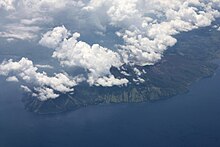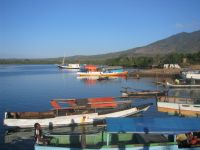|
Pantar
Pantar (Indonesian: Pulau Pantar) is the second largest island in the Indonesian Alor Archipelago, after Alor. To the east is the island of Alor and other small islands in the archipelago; to the west is the Alor Strait, which separates it from the Solor Archipelago. To the south is the Ombai Strait, and 72 kilometres (45 mi) away, the island of Timor. To the north is the Banda Sea. Pantar is about 50 kilometres (31 mi) north-to-south, and varies from 11 to 29 kilometres (6.8 to 18.0 mi) in east–west width. It has an area of 776.12 square kilometres (299.66 sq mi). The main towns on the island are Baranusa and Kabir. Administratively, the island is part of the Alor Regency. GeographyThe island consists of two distinct geographic zones. The eastern zone is dominated by a range of verdant hills which drop steeply to the coast of the Alor Strait. The western zone is relatively flat, consisting of a plain which gently slopes to the west from Mount Sirung, an 862-metre-high (2,828-foot) active volcano. The western zone is characteristically drier and much less densely populated than the eastern zone. Owing to its relatively low elevation, the entire island is drier than neighboring Alor. The dry season is long, interspersed with heavy rainfall during the rainy season, which peaks during January and February.  HistoryThe earliest written reference to Pantar is in the fourteenth-century Javanese poem Nagarakretagama, which describes the power and extent of the empire ruled by the fourth king of Majapahit, Hayam Wuruk. Pantar is referred to with the term 'Galiao', which is known in the Alor archipelago.[1] The precise location of the Majapahit dependency within Pantar is a subject of discussion.[2][3][4] EconomyThe economy is dominated by subsistence agriculture and fishing. The most common crops are rice, corn, and cassava. Crops are harvested annually in April and stored for consumption throughout the dry season. Excess production is sometimes traded for fish or to help support school children studying in the district capital of Kalabahi. Recently,[when?] commercial production of seaweed has been promoted along the north coast. A limited craft industry focused on ikat weaving is centered in Baranusa. Tourism remains underdeveloped, though a small dive resort was recently[when?] established on the northeast coast.  TransportationUntil 2021, access to the island was by water only. Pantar Airport was opened in March 2021, near the village of Kabir. It has a single paved runway 2,950ft in length. Small wooden power boats ply the route between Alor and Pantar daily, serving numerous communities. The state-run ferry serves Baranusa weekly between Kalabahi (Alor) and Larantuka (Flores). Administrative DistrictsThe island comprises five districts (kecamatan) of Alor Regency, tabulated below with their areas and their populations at the 2010 census[5] and the 2020 census,[6] together with the official estimates as at mid 2023.[7] The table also includes the locations of the district administrative centres, the number of villages (rural desa and urban kelurahan) in each district, and its post code. Eight small offshore islands are included within these districts.
Notes: (a) includes just the northern part of Pantar Island. (b) includes the kelurahan of Kabir. (c) includes offshore islands of Pulau Kura and uninhabited Batang and Lapang.
LanguagesAt least eight different languages are spoken on Pantar. These include at least five (dependent on classification) Papuan languages belonging to the Alor–Pantar family (Western Pantar, Sar, Blagar, Nedebang, and Kaera) as well as the Austronesian language Alorese. A small community of Bajau speakers is located north of Kabir. Local varieties of Malay and more standardized Indonesian are used as languages of wider communication.[13] See alsoReferences
External linksWikimedia Commons has media related to Pantar. |
||||||||||||||||||||||||||||||||||||||||||||||||||||||||||||||||||||||||||||||||||||||||||||||||||||||||||||||

